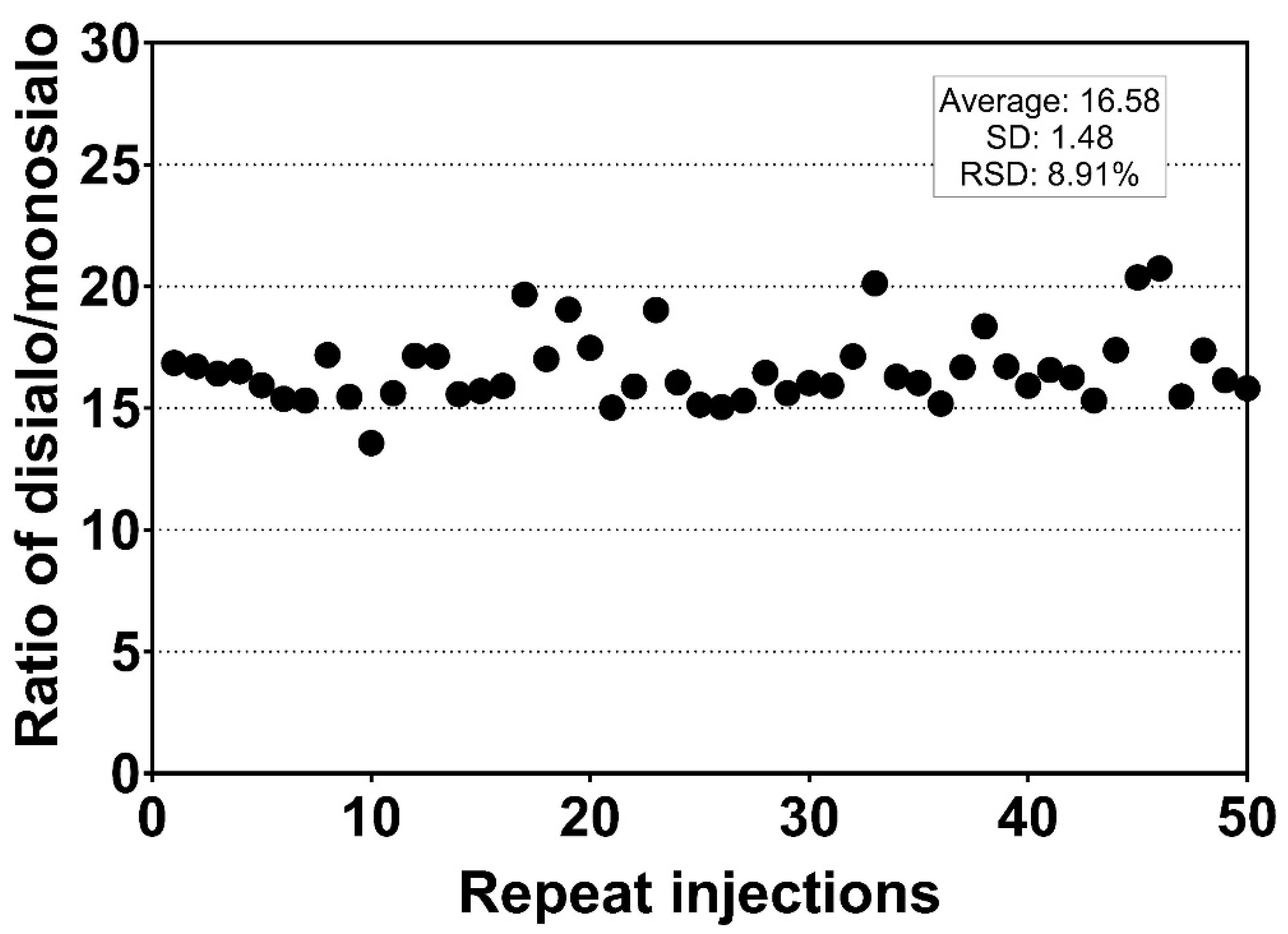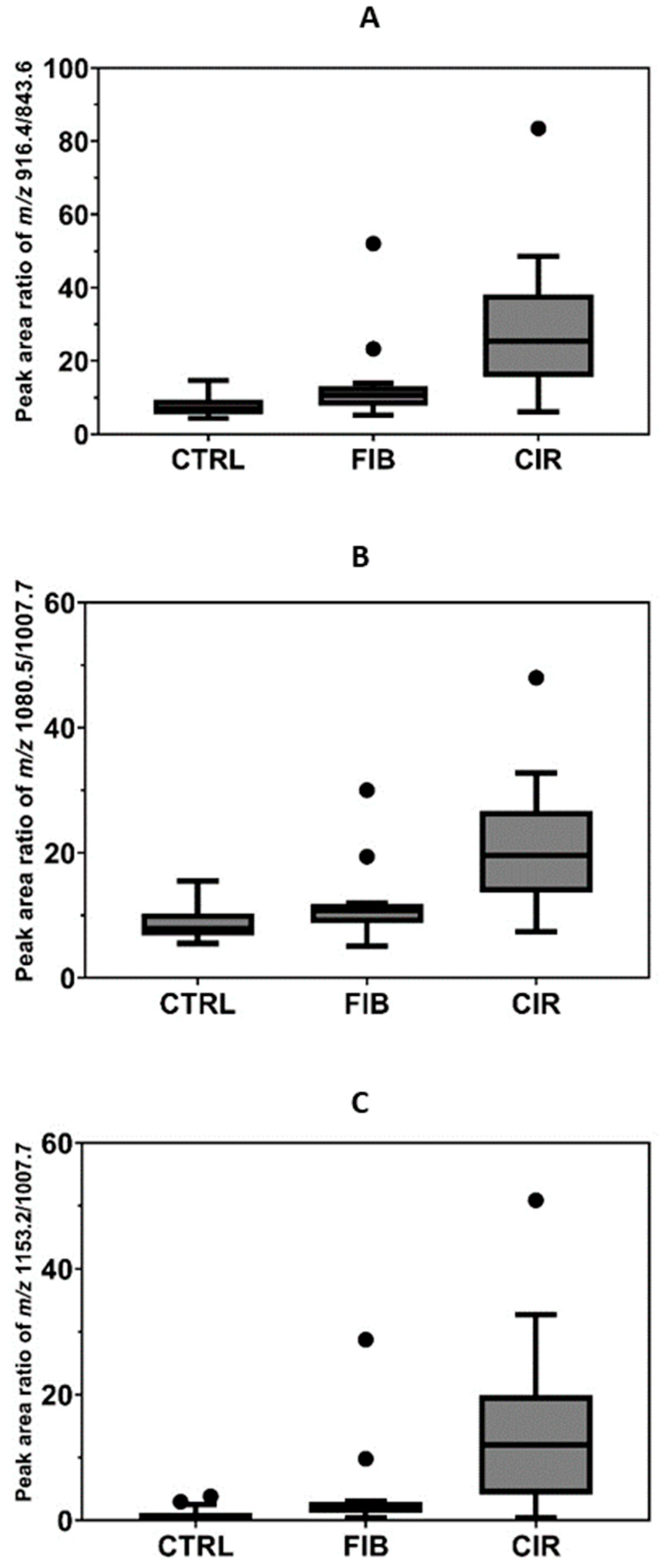A Rapid LC-MS/MS-PRM Assay for Serologic Quantification of Sialylated O-HPX Glycoforms in Patients with Liver Fibrosis
Abstract
:1. Introduction
2. Results and Discussion
2.1. Microflow LC-MS/MS for the Quantification of O-HPX
2.2. Application of the Micro-Flow LC-MS/MS Assay to Serum Samples of Liver Disease Patients
3. Materials and Methods
3.1. Materials
3.2. Sample Processing
3.3. Micro-Flow LC-MS/MS-PRM
3.4. Study Population
3.5. Data Analysis
Supplementary Materials
Author Contributions
Funding
Institutional Review Board Statement
Informed Consent Statement
Data Availability Statement
Acknowledgments
Conflicts of Interest
Sample Availability
References
- Angel, T.E.; Aryal, U.K.; Hengel, S.M.; Baker, E.S.; Kelly, R.T.; Robinson, E.W.; Smith, R.D. Mass Spectrometry-Based Proteomics: Existing Capabilities and Future Directions. Chem. Soc. Rev. 2012, 41, 3912–3928. [Google Scholar] [CrossRef] [PubMed] [Green Version]
- Vowinckel, J.; Zelezniak, A.; Bruderer, R.; Mülleder, M.; Reiter, L.; Ralser, M. Cost-Effective Generation of Precise Label-Free Quantitative Proteomes in High-Throughput by MicroLC and Data-Independent Acquisition. Sci. Rep. 2018, 8, 4346. [Google Scholar] [CrossRef] [PubMed] [Green Version]
- Sun, R.; Hunter, C.; Chen, C.; Ge, W.; Morrice, N.; Liang, S.; Zhu, T.; Yuan, C.; Ruan, G.; Zhang, Q.; et al. Accelerated Protein Biomarker Discovery from FFPE Tissue Samples Using Single-Shot, Short Gradient Microflow SWATH MS. J. Proteome Res. 2020, 19, 2732–2741. [Google Scholar] [CrossRef] [PubMed]
- Bian, Y.; Zheng, R.; Bayer, F.P.; Wong, C.; Chang, Y.C.; Meng, C.; Zolg, D.P.; Reinecke, M.; Zecha, J.; Wiechmann, S.; et al. Robust, Reproducible and Quantitative Analysis of Thousands of Proteomes by Micro-Flow LC-MS/MS. Nat. Commun. 2020, 11, 157. [Google Scholar] [CrossRef] [PubMed]
- Kuster, B.; Bian, Y.; Bayer, F.P.; Chang, Y.C.; Meng, C.; Hoefer, S.; Deng, N.; Zheng, R.; Boychenko, O. Robust Microflow LC-MS/MS for Proteome Analysis: 38 000 Runs and Counting. Anal. Chem. 2021, 93, 3686–3690. [Google Scholar] [CrossRef]
- Chen, Y.; Mao, P.; Wang, D. Quantitation of Intact Proteins in Human Plasma Using Top-Down Parallel Reaction Monitoring-MS. Anal. Chem. 2018, 90, 10650–10653. [Google Scholar] [CrossRef] [PubMed]
- Bian, Y.; The, M.; Giansanti, P.; Mergner, J.; Zheng, R.; Wilhelm, M.; Boychenko, A.; Kuster, B. Identification of 7000–9000 Proteins from Cell Lines and Tissues by Single-Shot Microflow LC-MS/MS. Anal. Chem. 2021, 93, 8687–8692. [Google Scholar] [CrossRef] [PubMed]
- Bringans, S.; Ito, J.; Casey, T.; Thomas, S.; Peters, K.; Crossett, B.; Coleman, O.; Ebhardt, H.A.; Pennington, S.R.; Lipscombe, R. A Robust Multiplex Immunoaffinity Mass Spectrometry Assay (PromarkerD) for Clinical Prediction of Diabetic Kidney Disease. Clin. Proteom. 2020, 17, 37. [Google Scholar] [CrossRef] [PubMed]
- Ni, W.; Jagust, W.; Wang, D. Multiplex Mass Spectrometry Analysis of Amyloid Proteins in Human Plasma for Alzheimer’s Disease Diagnosis. J. Proteome Res. 2021, 20, 4106–4112. [Google Scholar] [CrossRef] [PubMed]
- Ibrahim, S.; Lan, C.; Chabot, C.; Mitsa, G.; Buchanan, M.; Aguilar-Mahecha, A.; Elchebly, M.; Poetz, O.; Spatz, A.; Basik, M.; et al. Precise Quantitation of PTEN by Immuno-MRM: A Tool To Resolve the Breast Cancer Biomarker Controversy. Anal. Chem. 2021, 93, 10816–10824. [Google Scholar] [CrossRef] [PubMed]
- Sanda, M.; Benicky, J.; Wu, J.; Wang, Y.; Makambi, K.; Ahn, J.; Smith, C.I.; Zhao, P.; Zhang, L.; Goldman, R. Increased Sialylation of Site Specific O-Glycoforms of Hemopexin in Liver Disease. Clin. Proteom. 2016, 13, 24. [Google Scholar] [CrossRef] [PubMed] [Green Version]
- Benicky, J.; Sanda, M.; Pompach, P.; Wu, J.; Goldman, R. Quantification of Fucosylated Hemopexin and Complement Factor H in Plasma of Patients with Liver Disease. Anal. Chem. 2014, 86, 10716–10723. [Google Scholar] [CrossRef] [PubMed] [Green Version]
- Ginès, P.; Krag, A.; Abraldes, J.G.; Solà, E.; Fabrellas, N.; Kamath, P.S. Liver Cirrhosis. Lancet 2021, 398, 1359–1376. [Google Scholar] [CrossRef]
- El-Serag, H.B.; Rudolph, K.L. Hepatocellular Carcinoma: Epidemiology and Molecular Carcinogenesis. Gastroenterology 2007, 132, 2557–2576. [Google Scholar] [CrossRef] [PubMed]
- Mehta, A.; Herrera, H.; Block, T. Glycosylation and Liver Cancer. Adv. Cancer Res. 2015, 126, 257–279. [Google Scholar] [CrossRef] [PubMed] [Green Version]
- Zhu, J.; Warner, E.; Parikh, N.D.; Lubman, D.M. Glycoproteomic Markers of Hepatocellular Carcinoma-Mass Spectrometry Based Approaches. Mass Spectrom. Rev. 2019, 38, 265–290. [Google Scholar] [CrossRef] [PubMed]
- Ma, J.; Sanda, M.; Wei, R.; Zhang, L.; Goldman, R. Quantitative Analysis of Core Fucosylation of Serum Proteins in Liver Diseases by LC-MS-MRM. J. Proteom. 2018, 189, 67–74. [Google Scholar] [CrossRef] [PubMed]
- Di Bisceglie, A.M.; Shiffman, M.L.; Everson, G.T.; Lindsay, K.L.; Everhart, J.E.; Wright, E.C.; Lee, W.M.; Lok, A.S.; Bonkovsky, H.L.; Morgan, T.R.; et al. Prolonged Therapy of Advanced Chronic Hepatitis C with Low-Dose Peginterferon. N. Engl. J. Med. 2008, 359, 2429–2441. [Google Scholar] [CrossRef] [PubMed] [Green Version]





| Compound | m/z | z | Collision Energy (%) | Transitions Used for Quantitation |
|---|---|---|---|---|
| HexNAc-Hex-Neu5Ac | 843.6 | 4 | 20 | 905.8 |
| HexNAc-Hex-2Neu5Ac | 916.4 | 4 | 20 | 905.8 |
| 2HexNAc-2Hex-3Neu5Ac | 1080.5 | 4 | 20 | 905.8 |
| 2HexNAc-2Hex-4Neu5Ac | 1153.2 | 4 | 20 | 905.8 |
| 2HexNAc-2Hex-2Neu5Ac | 1007.7 | 4 | 20 | 905.8 |
| HexNAc | 973.5 | 3 | 20 | 905.8 |
| HexNAc-Hex | 770.9 | 4 | 20 | 905.8 |
Publisher’s Note: MDPI stays neutral with regard to jurisdictional claims in published maps and institutional affiliations. |
© 2022 by the authors. Licensee MDPI, Basel, Switzerland. This article is an open access article distributed under the terms and conditions of the Creative Commons Attribution (CC BY) license (https://creativecommons.org/licenses/by/4.0/).
Share and Cite
Panigrahi, A.; Benicky, J.; Wei, R.; Ahn, J.; Goldman, R.; Sanda, M. A Rapid LC-MS/MS-PRM Assay for Serologic Quantification of Sialylated O-HPX Glycoforms in Patients with Liver Fibrosis. Molecules 2022, 27, 2213. https://doi.org/10.3390/molecules27072213
Panigrahi A, Benicky J, Wei R, Ahn J, Goldman R, Sanda M. A Rapid LC-MS/MS-PRM Assay for Serologic Quantification of Sialylated O-HPX Glycoforms in Patients with Liver Fibrosis. Molecules. 2022; 27(7):2213. https://doi.org/10.3390/molecules27072213
Chicago/Turabian StylePanigrahi, Aswini, Julius Benicky, Renhuizi Wei, Jaeil Ahn, Radoslav Goldman, and Miloslav Sanda. 2022. "A Rapid LC-MS/MS-PRM Assay for Serologic Quantification of Sialylated O-HPX Glycoforms in Patients with Liver Fibrosis" Molecules 27, no. 7: 2213. https://doi.org/10.3390/molecules27072213
APA StylePanigrahi, A., Benicky, J., Wei, R., Ahn, J., Goldman, R., & Sanda, M. (2022). A Rapid LC-MS/MS-PRM Assay for Serologic Quantification of Sialylated O-HPX Glycoforms in Patients with Liver Fibrosis. Molecules, 27(7), 2213. https://doi.org/10.3390/molecules27072213







